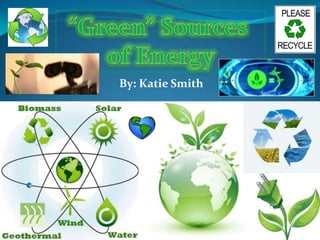Green Sources of Energy
- 3. ï Conventional Sources are most commonly used right now and can actually harm the environment and are Not renewable: ï Oil or Petroleum ï Nuclear Power ï Natural Gas ï Fossil Fuels ï Coal
- 4. ï Alternative Sources do Not harm the environment, and are renewable: ï Water Movement - Hydroelectric, Wave Energy ï Air Movement- Wind Power ï Earth - Geothermal Energy ï Biomass and Bio-fuels ï Sun - Solar Power
- 5. How much and Energy does the Iâm not saying itâs going to be easy, but Iâm telling you United States consume? itâs going to be worth it!
- 7. Solar Energy is the sunâs rays/solar radiation that reach the Earth. This energy can be converted into other forms of energy, such as heat and electricity. When converted to thermal (or heat) energy, solar energy can be used to: ï Heat water - for use in homes, buildings, or swimming pools ï Heat spaces - inside homes, greenhouses, and other buildings ï Heat fluids - to high temperatures to operate a turbine to generate electricity
- 8. ï Hydropower or water power is power derived from the energy of falling water, which may be harnessed for useful purposes. ï Though some flowing areas were made intentionally for this renewable energy source but this is capable of destroying natural habitats and biodiversity of aquatic animals. ï A solution has been made for fish who migrate up stream to spawn; it is called a fish ladder.
- 9. ï Is found in naturally occurring large areas of hydrothermal resources called geothermal reservoirs. Most reservoirs are deep underground with no visible clues showing above ground. But geothermal energy sometimes finds its way to the surface in the form of: ï Volcanoes and fumaroles (holes where volcanic gases are released) ï Hot springs ï Geysers
- 10. ï Biomass is organic material made from plants and animals (microorganisms) that contains stored energy from the sun. Plants absorb the energy through photosynthesis. The chemical energy in plants gets passed on to animals and people that eat them. ï Biomass is a renewable energy source because we can always grow more trees and crops. Some examples of biomass fuels are wood, crops, manure, and some garbage. ï When burned, the chemical energy in biomass is released as heat. If you have a fireplace, the wood you burn in it is a biomass fuel.
- 11. ï Today, wind energy is mainly used to generate electricity. Wind is a renewable energy source because the wind will blow as long as the sun shines. ï Just like windmills, todayâs wind turbines use blades to collect the windâs kinetic energy. The wind flows over the blades creating lift, like the effect on airplane wings, which causes them to turn. The blades are connected to a drive shaft that turns an electric generator to produce electricity. âĒA wind turbine works the opposite of a fan. Instead of using electricity to make wind, like a fan, wind turbines use wind to make electricity. The wind turns the blades, which spin a shaft, which connects to a generator and makes electricity.













